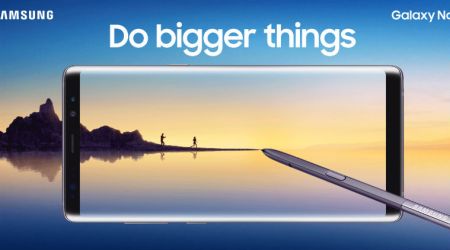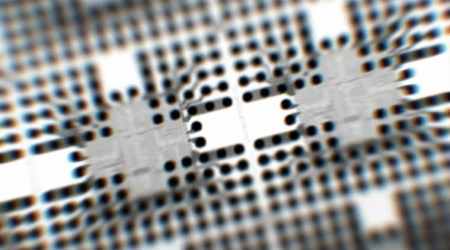 Samsung’s Galaxy Note 8 Galaxy Note 8 offers the edge-to-edge infinity screen design and the 18:5:9 aspect ratio.
Samsung’s Galaxy Note 8 Galaxy Note 8 offers the edge-to-edge infinity screen design and the 18:5:9 aspect ratio.
Smartphones with thick bezels will soon be passé as 2017 is slowly, but surely, turning out to be the year of the bezel-less smartphone. The trend will be cemented even more when Apple’s announces its much-anticipated next-gen smartphone, which as per rumours will get rid of the bezel too, just a couple of days from now.
Apple is preparing to radically change its design philosophy for the iPhone’s 10th anniversary. The biggest change we might see in the iPhone 8 will be the inclusion of an all-glass display covering the phone’s front, akin to Samsung’s Galaxy S8. Apple will be the latest company to join the bezel-less smartphone trend with the iPhone 8, which is also believed to be its most expensive smartphone.
Before the launch of the iPhone 8, South Korea’s Samsung has already launched the Galaxy Note 8, which offers an edge-to-edge infinity screen design and the 18:5:9 aspect ratio. Like the company’s Galaxy S8 series, the Galaxy Note 8’s screen dominates the front of the phone. Samsung plans to launch the Galaxy Note 8 in India on September 12, the same day Apple will launch the iPhone 8 in the US. The successor to the ill-fated Galaxy Note 7 could be priced upwards of Rs 65,000 for the base variant, which means the phone will be pitted against the iPhone 8 in more ways than one.
Then there is LG. While the South Korean company won’t able to match up to both Apple and Samsung in the marketing department, it is hard to ignore the V30. The company has squeezed the big screen into a relatively compact form factor, making the smartphone taller.
China’s Huawei is also anticipated to launch the Mate 10 and Mate 10 Pro on October 16 in Berlin. Both smartphones are said to feature thin bezels, and they will take on the likes of the iPhone 8 and Galaxy Note 8. Xiaomi, meanwhile, will launch its high-end, bezel-less smartphone on September 11 in Beijing. The Mi Mix 2 is expected to come with a 93 per cent screen-to-body ratio, which means it will feature a higher screen-to-body ratio than its predecessor. The Mi Mix 2 will succeed the original Mi Mix, which was released in October last year.
 Xiaomi Mi Mix 2 is expected to come with a 93 per cent screen-to-body ratio, which means it will feature a higher screen-to-body ratio than its predecessor. (Image of Xiaomi Mi Mix for representation)
Xiaomi Mi Mix 2 is expected to come with a 93 per cent screen-to-body ratio, which means it will feature a higher screen-to-body ratio than its predecessor. (Image of Xiaomi Mi Mix for representation)
Gionee also plans to launch a smartphone with negligible bezels, Shaikh Waris Ali, Director – Product & GTM, told Indianexpress.com. While the company isn’t revealing the details just yet, it says Gionee has already embraced this “phenomenon” and users will witness most of its “flagship products” getting launched in the near future with bezel-less designs. Gionee believes the bezel-less phone design is a new “premium” in the mobile industry.
Even Indian smartphone manufacturers don’t want to miss this emerging smartphone trend. Micromax recently launched the Canvas Infinity at a price below Rs 10,000, making it the cheapest smartphone with edge-to-edge display and an aspect ratio of 18:9.
Industry experts say more manufacturers will launch smartphones with thin bezels, and India could emerge as the top-destination for those players. “We expect major smartphone players including the Chinese vendors to come-up with thin bezel or bezel-less smartphones in the coming quarters. The popularity and rise of affordable flagships put pressure on smartphone players to refresh their portfolio constantly giving them less time to innovate and experiment. The rumoured launch of next generation iPhone with a bezel-less display and the popular launch of S8 flagship from Samsung earlier this year influenced the industry to make a transition towards bezel-less smartphone design to enhance user experience,” Shobhit Srivastava, Research Analyst, Mobile Devices and Ecosystems, told Indianexpress.com on email.
 Micromax Canvas Infinity is priced below Rs 10,000, making it the cheapest smartphone with edge-to-edge display and an aspect ratio of 18:9.
Micromax Canvas Infinity is priced below Rs 10,000, making it the cheapest smartphone with edge-to-edge display and an aspect ratio of 18:9.
But why go bezel-less?
Bezel-less smartphones have a certain advantage from a design point of view. Earlier smartphone manufacturers needed to create a bigger phone to include larger displays. Now, all thanks to the advancement in screen technology, manufacturers can create smaller, compact smartphones without compromising on screen size. For example, the Galaxy S8 has a taller 5.8-in QHD+ “Infinity” screen, with the top and bottom bezels of the phone are much smaller, giving it a screen-to-body ratio of 83 per cent. With the reduction in bezels, the Galaxy S8 offers more immersive experiences for viewing movies and playing games on the smartphone. In contrast, the iPhone 7 has a screen-to-body ratio of 65 per cent.
“Clearly, there is a practical limit to the physical size of a smartphone, typically determined by the size of the user’s hands or pockets. As a result, rather than increase the size of the device, handset OEMs are turning to solutions which increase the effective viewing area of the displays without increasing the overall size of the phones. These include bezel-less designs and new aspect ratios,” Srivastava explained.
“Bezel-less design uses the entire front panel as its display, leaving a powerful silhouette that surpasses the limits of current devices. The Home button has been removed to utilise its technical space to expand user space and shatter the boundary between the device and the real world. The grip is defined by how well a device’s curves fit in a hand. The subtle curvature of the device’s front, back, and middle convene at each of the edges to form a perfect symmetry, thereby virtually eliminating the bezel. The curves are harmoniously synchronised with the rounded edges to fit comfortably in a user’s hand,” Paul Sandip, Product designer and Innovation Consultant at Paul Studio, told Indianexpress.com.
“The bezel-less design definitely gives users an enhanced experience. For some it might seem a gimmick, but for those who appreciate human endeavors and like to push the envelope of possibility, this is quite inspiring,” added Sandip.
 With the V30, LG has squeezed the big screen into a relatively compact form factor and making the smartphone taller.
With the V30, LG has squeezed the big screen into a relatively compact form factor and making the smartphone taller.
Bezel-less design: Far from perfect
Sure, smartphone displays are increasing in size without requiring larger devices. The bezel-less smartphones promise gorgeous displays, however, it also makes the devices more prone to shattering and accidental damage. The idea of bezel-less smartphones is interesting, but keep in mind that they are easier to break. Since the screens are more closer to the edge of the phone, they are less rugged in nature compared to a phone with thick bezels. They can be expensive to replace as well, which results in an immensely frustrating experience for a common user.
No doubt it’s easy to hold the bezel-less phone in hand; it feels nice but the 18.:9 aspect ratio is a little different from the 16:9 standard. The 18:9 screen can’t take advantage of the entire screen when watching videos. Yes, big bezels are gone but it’s not making the smartphone experience any better.
But questions remains: do you actually need a phone with a bezel-less design? It’s no big deal if there are bezels around the edges of the phone. Concept-wise, yes, bezel-less smartphones are highly futuristic, but there’s no real benefit at the moment. We haven’t heard consumers asking for a bezel-less smartphone just yet. That being said, smartphone manufacturers will continue to come with bezel-less smartphones and they will do everything to grab your attention.

